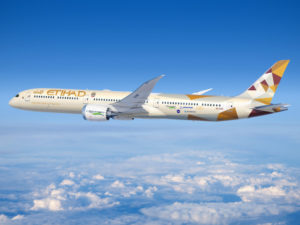Collaboration with Boeing, NASA and Safran to improve the sustainability of air travel
An Etihad Airways 787-10 Dreamliner decked out with special equipment that can enhance safety and reduce CO2 emissions and noise has commenced flight testing this week for Boeing’s ecoDemonstrator programme.

A series of flights will gather the most detailed information to date about aircraft acoustics from some 1,200 microphones attached to the outside of the 787 and positioned on the ground. The collaboration between NASA and Boeing will improve the agency’s aircraft noise prediction capabilities, advance ways for pilots to reduce noise and inform future quiet aircraft designs.
“At NASA, we’ve been researching the individual airplane noise sources, their interactions with the airframe and how they combine to the total aircraft noise,” noted Dr. Russell Thomas, NASA technical lead.
Blue sky opportunities
“By choosing to take part in this programme we are proud to work with the likes of Boeing, NASA and Safran to test cutting-edge technologies and explore ‘blue sky’ opportunities to improve airspace efficiency, reduce fuel use, lower noise for the community and cut CO2 emissions,” asserted Mohammad Al Bulooki, Etihad Aviation Group Chief Operating Officer.
“As far as Etihad is concerned, environmental sustainability shouldn’t be an option or fair-weather project to be shelved when it’s not convenient against other challenges,” he added.
Most community complaints about aircraft noise stem from flights approaching airports, according to industry figures. About one-quarter of the noise is created by the landing gear. Another project will test landing gear modified to be quieter by Safran Landing Systems.
“Our collaboration with NASA and Safran is key to accelerating innovation and furthering the ecoDemonstrator’s mission to improve the sustainability of air travel,” stressed ecoDemonstrator Program Chief Engineer Rae Lutters.
Two flights are being conducted during which pilots, air traffic controllers and an airline’s operations centre simultaneously share digital information and use a NASA system called tailored arrival management. These tools enhance safety by reducing workload and radio frequency congestion, optimise routing efficiency to lower fuel use, emissions and noise, and support the FAA’s Next Generation Air Transportation System.
Travel initiative
As part of Boeing’s Confident Travel Initiative to address the pandemic, a handheld ultraviolet light wand will be tested to determine its effectiveness in disinfecting flight decks and cabins.
All scheduled test flights are being flown on a blend of up to 50% sustainable fuel, which includes the largest volumes of 50% blend biofuel commercially produced. Flight testing at Boeing’s facility in Glasgow, Montana, USA, is expected to last about 10 days before the aircraft is delivered to Etihad in late September.
This is the latest programme under Etihad’s industry-leading strategic partnership with Boeing, focusing on innovating real-world solutions to the key sustainability challenges facing the aviation industry.
This is the first time the ecoDemonstrator programme is using a Boeing 787-10 since flight testing began in 2012.
